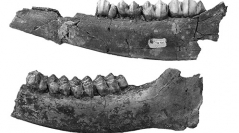

 Geodiversitas
38 (2) - Pages 273-298
Geodiversitas
38 (2) - Pages 273-298The upper Miocene vertebrate locality of Küçükçekmece West, European Turkey, had provided an artiodactyl assemblage that is rich in species but poor in specimens. The present study allows revising previous artiodactyl lists provided for this site, by recognizing Hippopotamodon cf. antiquus, Dorcatherium maliki n. sp., Palaeotragus sp. (large size), Palaeogiraffa pamiri (Ozansoy, 1965), Bohlinia cf. attica, Gazella cf. ancyrensis, Majoreas cf. elegans, Prostrepsiceros sp., aff. Protoryx cf. enanus, cf. Miotragocerus sp., and Bovidae indet. (large size). The presence of a second suine and a cervid are poorly supported by current data but not excluded. The bulk of this artiodactyl association is also recognized in the Küçükçekmece East fossil assemblage. The Küçükçekmece tragulid is allocated to a new species of a medium sized Dorcatherium with bunoselenodont dentition, long premolars, tricuspid dp2 (p2) and p3, long hypoconid on dp2 and p3, simple distal fossette on p4, and presence of a lingual protocristid on the lower molars. The artiodactyl association of Küçükçekmece points to a Vallesian age, possibly between 9.6-9.4 Ma. The predominance of Dorcatherium and Palaeogiraffa among artiodactyls indicates wooded environmental conditions, whereas the taxonomic spectrum of artiodactyls reveals main influences from both Anatolia and Southern Balkans.
Vallesian, SE Europe, Suidae, Tragulidae, Giraffidae, Bovidae, new species